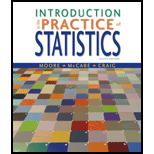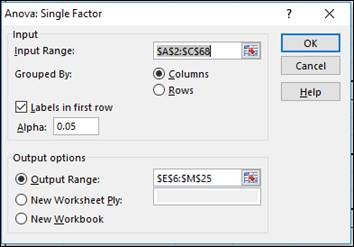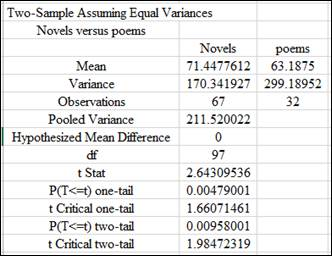
Concept explainers
(a)
To find: The summary from the data.
(a)
Answer to Problem 46E
Solution: The summary from the data is as shown below:

Explanation of Solution
Calculation: To draw the inference from the data, use Excel. Steps are provided below:
Step 1: Open Excel sheet and write the value for three treatments. The screenshot is shown below:

Step 2: The

The sample size for “Poems” can be obtained by using the formula

The sample size for “Nonfiction” can be obtained by using the formula

Step 3: The average value for “Novels” can be obtained by using the formula

The average value for “Poems” can be obtained by using the formula

The average value for “Nonfiction” can be obtained by using the formula

Step 4: The standard deviation for “Novels” can be obtained by using the formula

The standard deviation for “Poems” can be obtained by using the formula

The standard deviation for “Nonfiction” can be obtained by using the formula

Step 5: The standard error for “Novels” can be obtained by using the formula

The standard error for “Poems” can be obtained by using the formula

The standard error for “Nonfiction” can be obtained by using the formula

The result is obtained.
The screenshot of the summary of results is shown below:

(b)
Necessary assumption to carry out ANOVA test.
(b)
Answer to Problem 46E
Solution: All the distribution are approximately normal and pooling of standard deviation is applicable.
Explanation of Solution
(c)
To test: The ANOVA model.
(c)
Answer to Problem 46E
Solution: The required ANOVA model is obtained as follows:
Here, the F value is greater than the F critical value. Hence, the null hypothesis can be rejected significantly.
Explanation of Solution
Calculation: Single factor ANOVA model is performed by following these steps:
Step 1: Open Excel sheet and write the value for three treatments. The screenshot is shown below:

Step 3: Data > Data Analysis > OK. The screenshot is shown below:

Step 4: Select ANOVA: Single Factor > OK. The screenshot is shown below:

Step 5: Select input

The model is obtained. The screenshot is shown below:

Conclusion: Here, the F value is greater than the F critical. Hence, null hypothesis can be rejected significantly.
(d)
To test: The contrast to compare the poets with the writers.
(d)
Answer to Problem 46E
Solution: The P value is
Explanation of Solution
A contrast (c) is defined as a combination of population means.
where
The null hypothesis,
where
The null hypothesis is tested to compare novelists with the nonfiction writers. The following steps are followed with reference to part (c) on excel to test the null hypothesis:
Step 1: Contrast c is calculated as follows:
Step 2: The pooled standard deviation is obtained as follows:
Step 3: Standard error of contrast is obtained as follows:
Step 4: The resultant t statistic can be calculated as follows:
(e)
To test: A contrast to compare the novelists with the nonfiction writers.
(e)
Answer to Problem 46E
Solution: The p- value is
Explanation of Solution
Step 1: Contrast c is calculated as follows:
Step 2: The pooled standard deviation is obtained as follows:
Step 3: Standard error of contrast can be calculated as follows:
Step 4: The resultant t statistic can be calculated as follows:
Conclusion: The p- value is
(f)
To test: The multiple comparison t test.
(f)
Answer to Problem 46E
Solution: The poem’s mean is significantly different from other means.
Explanation of Solution
Calculation:
Multiple comparison t-test is performed by following these steps:
Step 1: Open Excel sheet and write the value for three treatments. The screenshot is shown below:

Step 2: Data > Data Analysis > OK. The screenshot is shown below:

Step 3: Select t-test: Two-Sample Assuming Equal Variances > OK. The screenshot is shown below:

Step 4: Select input range > OK. The screenshot is shown below:

Step 5: Repeat step 5 to compare low dose versus high dose and control versus high dose.
The result for comparison of novels versus poems is obtained as follows:

The result for comparison of poems versus nonfiction is obtained as follows:

The result for comparison of novels versus nonfiction is obtained as follows:

Conclusion: From the above comparison, the P value for two-tail for poems versus novels and poems versus nonfiction is less than 0.05 at 5% significance level. Hence, poem’s mean is significantly different from other means.
Want to see more full solutions like this?
Chapter 12 Solutions
Introduction to the Practice of Statistics: w/CrunchIt/EESEE Access Card
- Please show as much work as possible to clearly show the steps you used to find each solution. If you plan to use a calculator, please be sure to clearly indicate your strategy. Consider the following game. It costs $3 each time you roll a six-sided number cube. If you roll a 6 you win $15. If you roll any other number, you receive nothing. a) Find the expected value of the game. b) If you play this game many times, will you expect to gain or lose money?arrow_forward= 12:02 WeBWorK / 2024 Fall Rafeek MTH23 D02 / 9.2 Testing the Mean mu / 3 38 WEBWORK Previous Problem Problem List Next Problem 9.2 Testing the Mean mu: Problem 3 (1 point) Test the claim that the population of sophomore college students has a mean grade point average greater than 2.2. Sample statistics include n = 71, x = 2.44, and s = 0.9. Use a significance level of a = 0.01. The test statistic is The P-Value is between : The final conclusion is < P-value < A. There is sufficient evidence to support the claim that the mean grade point average is greater than 2.2. ○ B. There is not sufficient evidence to support the claim that the mean grade point average is greater than 2.2. Note: You can earn partial credit on this problem. Note: You are in the Reduced Scoring Period. All work counts for 50% of the original. Preview My Answers Submit Answers You have attempted this problem 0 times. You have unlimited attempts remaining. . Oli wwm01.bcc.cuny.eduarrow_forwardThere are four white, fourteen blue and five green marbles in a bag. A marble is selected from the bag without looking. Find the odds of the following: The odds against selecting a green marble. The odds in favour of not selecting a green marble The odds in favor of the marble selected being either a white or a blue marble. What is true about the above odds? Explainarrow_forward
- Please show as much work as possible to clearly show the steps you used to find each solution. If you plan to use a calculator, please be sure to clearly indicate your strategy. 1. The probability of a soccer game in a particular league going into overtime is 0.125. Find the following: a. The odds in favour of a game going into overtime. b. The odds in favour of a game not going into overtime. c. If the teams in the league play 100 games in a season, about how many games would you expect to go into overtime?arrow_forwardexplain the importance of the Hypothesis test in a business setting, and give an example of a situation where it is helpful in business decision making.arrow_forwardA college wants to estimate what students typically spend on textbooks. A report fromthe college bookstore observes that textbooks range in price from $22 to $186. Toobtain a 95% confidence level for a confidence interval estimate to plus or minus $10,how many students should the college survey? (We may estimate the populationstandard deviation as (range) ÷ 4.)arrow_forward
- In a study of how students give directions, forty volunteers were given the task ofexplaining to another person how to reach a destination. Researchers measured thefollowing five aspects of the subjects’ direction-giving behavior:• whether a map was available or if directions were given from memory without a map,• the gender of the direction-giver,• the distances given as part of the directions,• the number of times directions such as “north” or “left” were used,• the frequency of errors in directions. Identify each of the variables in this study, and whether each is quantitative orqualitative. For each quantitative variable, state whether it is discrete or continuous. Was this an observational study or an experimental study? Explain your answer.arrow_forwardexplain the difference between the confident interval and the confident level. provide an example to show how to correctly interpret a confidence interval.arrow_forwardSketch to scale the orbit of Earth about the sun. Graph Icarus’ orbit on the same set of axesWhile the sun is the center of Earth’s orbit, it is a focus of Icarus’ orbit. There aretwo points of intersection on the graph. Based on the graph, what is the approximate distance between the two points of intersection (in AU)?arrow_forward
- The diameters of ball bearings are distributed normally. The mean diameter is 67 millimeters and the standard deviation is 3 millimeters. Find the probability that the diameter of a selected bearing is greater than 63 millimeters. Round to four decimal places.arrow_forwardSuppose you like to keep a jar of change on your desk. Currently, the jar contains the following: 22 Pennies 27 Dimes 9 Nickels 30 Quarters What is the probability that you reach into the jar and randomly grab a penny and then, without replacement, a dime? Express as a fraction or a decimal number rounded to four decimal places.arrow_forwardA box contains 14 large marbles and 10 small marbles. Each marble is either green or white. 9 of the large marbles are green, and 4 of the small marbles are white. If a marble is randomly selected from the box, what is the probability that it is small or white? Express as a fraction or a decimal number rounded to four decimal places.arrow_forward
 MATLAB: An Introduction with ApplicationsStatisticsISBN:9781119256830Author:Amos GilatPublisher:John Wiley & Sons Inc
MATLAB: An Introduction with ApplicationsStatisticsISBN:9781119256830Author:Amos GilatPublisher:John Wiley & Sons Inc Probability and Statistics for Engineering and th...StatisticsISBN:9781305251809Author:Jay L. DevorePublisher:Cengage Learning
Probability and Statistics for Engineering and th...StatisticsISBN:9781305251809Author:Jay L. DevorePublisher:Cengage Learning Statistics for The Behavioral Sciences (MindTap C...StatisticsISBN:9781305504912Author:Frederick J Gravetter, Larry B. WallnauPublisher:Cengage Learning
Statistics for The Behavioral Sciences (MindTap C...StatisticsISBN:9781305504912Author:Frederick J Gravetter, Larry B. WallnauPublisher:Cengage Learning Elementary Statistics: Picturing the World (7th E...StatisticsISBN:9780134683416Author:Ron Larson, Betsy FarberPublisher:PEARSON
Elementary Statistics: Picturing the World (7th E...StatisticsISBN:9780134683416Author:Ron Larson, Betsy FarberPublisher:PEARSON The Basic Practice of StatisticsStatisticsISBN:9781319042578Author:David S. Moore, William I. Notz, Michael A. FlignerPublisher:W. H. Freeman
The Basic Practice of StatisticsStatisticsISBN:9781319042578Author:David S. Moore, William I. Notz, Michael A. FlignerPublisher:W. H. Freeman Introduction to the Practice of StatisticsStatisticsISBN:9781319013387Author:David S. Moore, George P. McCabe, Bruce A. CraigPublisher:W. H. Freeman
Introduction to the Practice of StatisticsStatisticsISBN:9781319013387Author:David S. Moore, George P. McCabe, Bruce A. CraigPublisher:W. H. Freeman





